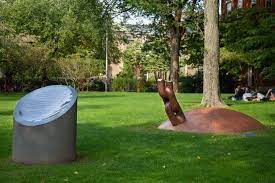Table of Contents
Monument and Inspiration
Research needs to be done into the descendants of the enslaved people and if they are still alive they should be consulted in planning any possible monument. Community members especially within the Black community should be involved in the creation of a monument.
The monument should be created with the community involved to best meet the needs of the community. There is not much of a Black community in South Hadley therefore neighboring towns and communities should be consulted to address slavery in the larger area of Western Massachusetts. With any consultations with Black communities and individuals, there needs to be a plan for monetary compensation for their time and energy.
A helpful article on reparations is worth giving a look at:
Marla R. Miller & Karen Sánchez-Eppler (2021)Joining reinterpretation to reparations , Museums & Social Issues, 15:1-2, 72-82.
Here are some monuments that we believe have a lot of potential and things to use as inspiration and jumping-off points along with our thoughts on them.
Witness Stones-

Witness Stones memorialized enslaved people and bring awareness to the existence of slavery in its given location.
Restore history, educate, and honor humanity. Witness Stones Project Inc. (n.d.). Retrieved April 28, 2023, from https://witnessstonesproject.org/
The witness stone project explores and memorializes the lives of people who through historic tragedies and injustices were robbed of lives and proper memorials. They set out to possibly stop people in their tracks, look down, realize what they have just stumbled on, and reflect on this person’s life. The interesting element about these is the accessibility, they are in the street, they are in places where some people might not intentionally seek them out, and that is where they succeed in accessibility, they pull people in who did not set out to engage necessarily. Beginning in Europe, specifically Germany to memorialize Holocaust victims, they were placed usually in front of the last chosen home of the person. In the U.S. in the context of slavery these stones are placed at the place where they were enslaved because their last chosen place of residence was not in the U.S. Also referred to as “Stumbling stones” one objective is that people will stumble over this grave marker in a way, and, then given the size of the stone, forces the audience to kneel to investigate more. The kneeling could resemble that of a prayer position. The act of stepping over someone is also one to make someone pounder. In some contexts this could produce renowned contemplation, however, it is also a possibly triggering moment for someone with generational trauma, to be faced with the reminder of such tragedy when they do not expect it.
Some objections to this type of memorial are that the act of stepping over the stones is viewed as disrespectful and some people may view it as not a proper memorial if you allow people to step over it. This complicated nuance needs to be deeply discussed and consulted with many experts and community members. The decision to put in a memorial similar to the witness stones would need the conscience of knowing the ways people may negatively react to it. The most important aspect of the witness stones is how it would bring the community together, it’s not an installation that lives in a museum or a temporal space but something that needs constant engagement and care to stay present.
The Legacy Museum- The National Memorial for Peace and Justice https://museumandmemorial.eji.org/
This museum and memorial in Montgomery memorialize the lives of black people who were brutally murdered by lynching. It offers a space for healing and processing, while also sheds light on a travesty in this country.

Brown University, Slavery Memorial https://www.brown.edu/about/public-art/martin-puryear-slavery-memorial
This memorial at Brown University was created in 2014 by Martin Puryear after the university conducted a study in 2003 into the university’s relationship to the trans-Atlantic slave trade. This memorial is meant to remember Rhode Island’s ties to the slave trade and how the university was built by enslaved and free Black people.

Other things to consider- the landscape and geography of South Hadley are something to take into account when brainstorming possible monuments. In our topical guide, you can find information about locations within South Hadley that have connections to slavery. It is overlayed with the current South Hadley geography. Using modern-day geography with the history of enslavement one could successfully educate and situate this history into residents who are familiar with South Hadley. With this idea of mapping, we have discussed possible online maps and or QR codes to make this information accessible to more.
We believe that any memorial or installation should serve as an educational opportunity and offer space for reflection and healing. It is also vital that if a memorial is to be installed it is in South Hadley, and for South Hadley residents and neighboring communities.